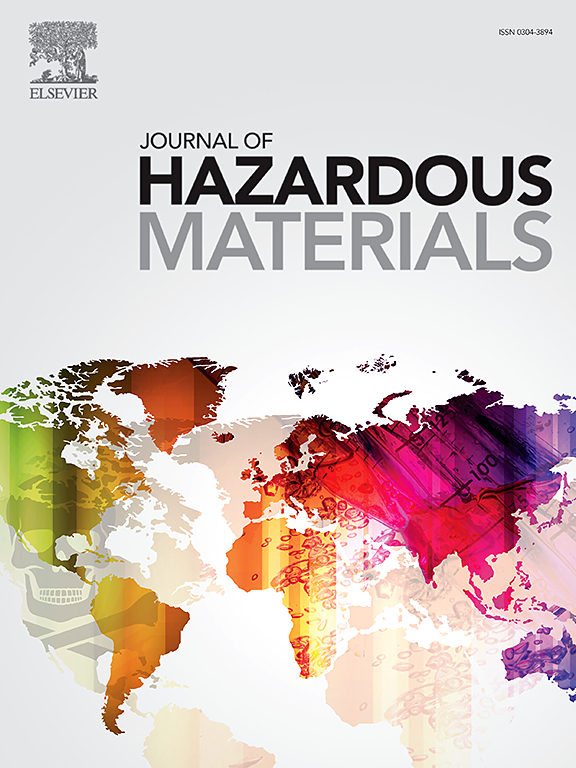IF 12.2
1区 环境科学与生态学
Q1 ENGINEERING, ENVIRONMENTAL
引用次数: 0
摘要
有机磷农药(OPs)因其在农业和公共卫生领域的广泛应用而备受关注。其中,偶氮甲环磷(AZA)可能会通过食物链积累对非目标生物和人类健康造成危害。因此,建立一种高灵敏度和特异性的 AZA 检测方法对确保食品安全和生态保护具有重要意义。本研究基于氧化石墨烯-SELEX技术,首次筛选出了对AZA具有特异性识别能力(Kd=26.27±1.27 nM)的aptamer(Apt)。随后,该适配体与分子印迹聚合物相结合,构建了一种双重识别电化学传感器,充分利用了两种识别元素的互补优势。这种双识别策略能够协同增强特异性识别能力,有效减少非目标物质的干扰,提高传感器的选择性和准确性。此外,还采用了掺杂策略,用 AuNPs@SnS2@ZnCo-MOF 纳米复合材料修饰电极表面,提高了电子传递效率,提供了丰富的活性位点,从而显著提高了电化学信号响应。该传感器的检测范围宽(1.00×10-2-1.00×104 ng/mL),检测限低(3.33×10-3 ng/mL),同时还表现出优异的稳定性和特异性。综上所述,该研究开发了一种高效、灵敏、选择性强的电化学传感器,为快速检测 AZA 及其他有机磷农药提供了一种新策略,在食品安全和环境监测领域具有广阔的应用前景。本文章由计算机程序翻译,如有差异,请以英文原文为准。

GO-SELEX-enhanced dual-recognition sensor for highly specific detection of azamethiphos
Organophosphorus pesticides (OPs) have attracted attention due to their widespread application in agriculture and public health. Among them, azamethiphos (AZA) may pose risks to non-target organisms and human health through food chain accumulation. Therefore, establishing a highly sensitive and specific detection method of AZA is of great significance for ensuring food safety and ecological protection. In this study, based on graphene oxide-SELEX technology, an aptamer (Apt) with specific recognition for AZA (Kd=26.27±1.27 nM) was screened for the first time. This aptamer was subsequently integrated with molecularly imprinted polymers to construct a dual-recognition electrochemical sensor, leveraging the complementary advantages of both recognition elements. This dual-recognition strategy enabled the synergistic enhancement of specific recognition ability, effectively reducing interference from non-target substances and improving sensor selectivity and accuracy. Additionally, a doping strategy was adopted to modify the electrode surface with AuNPs@SnS2@ZnCo-MOF nanocomposites, improving electron transfer efficiency and providing abundant active sites, thereby significantly enhancing the electrochemical signal response. The sensor exhibited a wide detection range (1.00×10-2-1.00×104 ng/mL) and a low limit of detection (3.33×10-3 ng/mL), while also demonstrating excellent stability and specificity. In summary, this study developed a highly efficient, sensitive and selective electrochemical sensor, providing a novel strategy for the rapid detection of AZA and other organophosphorus pesticides, with broad application prospects in food safety and environmental monitoring.
求助全文
通过发布文献求助,成功后即可免费获取论文全文。
去求助
来源期刊

Journal of Hazardous Materials
工程技术-工程:环境
CiteScore
25.40
自引率
5.90%
发文量
3059
审稿时长
58 days
期刊介绍:
The Journal of Hazardous Materials serves as a global platform for promoting cutting-edge research in the field of Environmental Science and Engineering. Our publication features a wide range of articles, including full-length research papers, review articles, and perspectives, with the aim of enhancing our understanding of the dangers and risks associated with various materials concerning public health and the environment. It is important to note that the term "environmental contaminants" refers specifically to substances that pose hazardous effects through contamination, while excluding those that do not have such impacts on the environment or human health. Moreover, we emphasize the distinction between wastes and hazardous materials in order to provide further clarity on the scope of the journal. We have a keen interest in exploring specific compounds and microbial agents that have adverse effects on the environment.
 求助内容:
求助内容: 应助结果提醒方式:
应助结果提醒方式:


